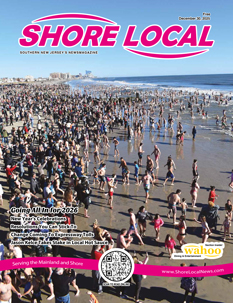If a Category 3 hurricane hit Absecon Island, only the area near Borgata would be safe from flooding
By Joe Martucci
Certified Broadcast Meteorologist
and Certified Digital Meteorologist
Picture this – a Category 3 hurricane, quickly moving up the Jersey Shore from south to north, in a track similar to Hurricane Irene in 2011. It would be the most powerful hurricane to impact us since the Great Atlantic Hurricane of 1944, which skirted east of the coastline by about 50 miles.
If it made landfall, it would be the first landfalling hurricane in New Jersey since the Vagabond Storm of 1903 (a reminder that Sandy was officially a post-tropical cyclone, not a hurricane, at landfall near Brigantine). Furthermore, it would be the first major hurricane, Category 3 or greater, since at least Sept. 3, 1821, which was estimated to be a Category 3 or 4, according to the National Weather Service.
Hurricane Milton captured America’s consciousness last week when it made landfall on the west coast of Florida, near Siesta Key on Tuesday, Oct. 8, as a Category 3 hurricane, according to the National Hurricane Center. Three million people lost power in Florida, 45 tornadoes were reported and major coastal flooding occurred from Naples north to near Port Charlotte.
More amazing to me is how much focus we had on Milton just two weeks after Hurricane Helene made landfall in the Big Bend of Florida. Typically, society becomes numb to similar events in succession. Not this time, though.
It was an excellent forecast on the part of the National Hurricane Center, which had Siesta Key in its hurricane forecast since the Saturday prior.
Many of you reacted to a video and social post on Oct. 9 about what a Category 3, like Hurricane Milton, would mean to the Jersey Shore in terms of storm surge. It is a good teaching moment. With our interest in hurricanes high, and New Jersey, fortunately, enjoying plenty of dry, comfortable weather, it made sense to talk about it. Let’s explore it further.
A Few Housekeeping Notes
The possibility of a Category 3 hurricane running north up the Jersey Shore is not hyperbole. This is a real scenario that emergency managers, and meteorologists, prepare for as a reasonable worst-case scenario for New Jersey.
Each year, there’s a 1.3% to 1.5% chance of a major hurricane being within 50 miles of the Jersey Shore, according to the National Hurricane Center. Put in other words, it’s a 1-in-68-year event near Cape May, and a 1-in-76-year event in Ocean County.
We need to be realistic about how the storm would evolve. A Sandy-like path into New Jersey, moving from east to west, would be very unlikely, as it would have plenty of time to weaken in the cooler ocean waters of our latitude. To be a Category 3, it would likely have to be a Category 4 or 5 near the Carolinas and move quickly north. This would be a quick hitter – a few hours of fury.
Finally, each town’s infrastructure can handle storm surge differently. It’s entirely possible that some flooding could be avoided.
Storm Surge in a Category 3 NJ Hurricane
For most of us at and near the shore, this is what we’re most concerned with. The good news is that, since this would likely move from south to north at a good pace, we would likely only have one significant high tide. There would probably be a second high tide with minor to moderate stage flooding, which we are generally used to. However, that high tide would be powerful.
The National Oceanic and Atmospheric Administration’s Flood Exposure tool shows what a Category 3 storm surge would look like. On Absecon Island, 99% of it would be underwater. Most of it would have more than 9 feet of surge above normally dry land. You would need to be well elevated just to have a chance at survival.
Along Atlantic Avenue, it would be 6 to 9 feet. The only place where storm surge wouldn’t occur would be near the Borgata Hotel Casino & Spa, since it’s elevated enough there. There’s precedent for this. In the 1944 Great Atlantic Hurricane, the boardwalk hotels had water in their lobbies. The Steel Pier was partially destroyed.
In a Category 3, Ocean City would suffer a similar fate with more than 9 feet of storm surge for nearly all of the city. It would not be survivable for many. Strathmere would be the same.
It would be nearly impossible to escape off the islands during this storm. The Atlantic City Expressway is raised up to 10 feet above the wetlands. So, it would be passable, though getting onto the Expressway first would be very tough.
Head inland and the flooding would occur in places rarely, if ever, seen before in our lifetimes. In Upper Township, virtually everywhere east of Route 9 would have water. Tuckahoe would have storm surge as water spilled over the Great Egg Harbor River.
Move north over the river to Somers Point and expect at least 3 feet of storm surge nearly everywhere west of New Road. Bay Avenue could be under 9 feet of water. Route 52 would be flooded from the bridge to Route 9.
In Linwood and Northfield, the blocks that border the marshes would be under at least a foot of water. Anywhere west of Route 9 in the towns could also have at least a foot of storm surge.
Jeffers Landing and Morris Beach in Egg Harbor Township would be devastated with 9 feet of storm surge.
After the storm passed by, powerful offshore winds would blow. That would push the water out nearly as quickly as it came in. We would likely experience a blowout tide for the area. We saw that in St. Petersburg and Tampa with Hurricane Milton. That would be a help after that incoming tide.
Winds in a Category 3 NJ Hurricane
A Category 3 hurricane has maximum sustained winds between 111 mph and 129 mph on the Saffir-Simpson scale.
Typically, those wind speeds are over water. When it comes ashore, the wind speeds slow down. Still, using the 1944 hurricane as a reference, the top sustained winds were 96 mph. For reference, during Sandy, our maximum sustained wind at the South Jersey shore was 55 mph in Brigantine, according to the National Weather Service.
Figure that sustained winds would be 85-95 mph at their peak, with a four-hour duration of tropical storm-force winds or greater (39 mph). We have improved our housing stock and power grid tremendously since Sandy. However, this would definitely take a severe toll.
Beach Erosion in a Category 3 NJ Hurricane
You could reasonably expect severe beach and dune loss up and down the coast. It would take years to recover. The shore north of Brigantine averaged 2 to 6 meters of vertical loss during Sandy. If a storm ran up the coast from south to north, expect similar numbers across the entire shore.
Rainfall in a Category 3 NJ Hurricane
This is the least certain part of the forecast. A stronger hurricane doesn’t always mean more rain. Plus, the storm would likely move pretty quickly.
We can use the 1944 hurricane as a guide here. Our region saw 4 to 6 inches of rain. That would exaggerate the storm surge going on. Furthermore, if your house has a basement, it could very well flood. However, this would likely be the least impactful part of the storm.
Joe earned his Meteorology Degree from Rutgers University. He is approved by the American Meteorological Society as a Certified Broadcast Meteorologist and Certified Digital Meteorologist, the only one in the state with both. He’s won 10 New Jersey Press Association Awards. You can find him on social media @joemartwx










